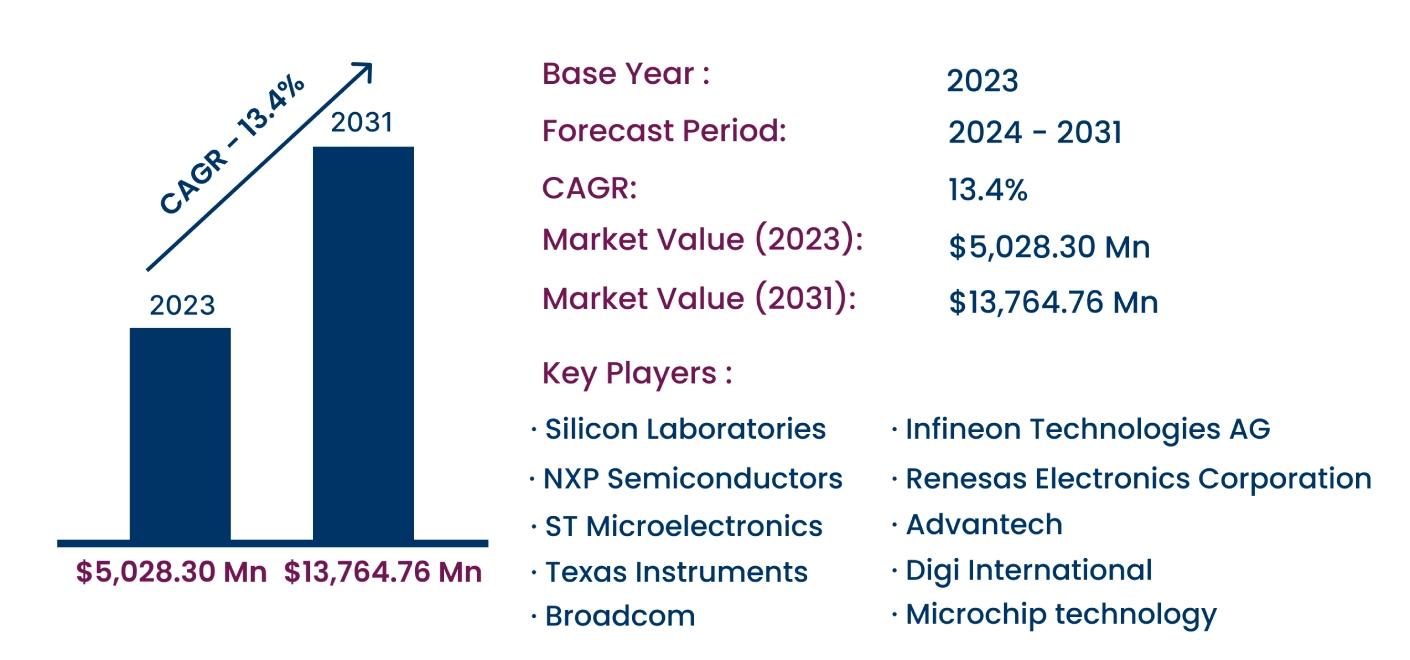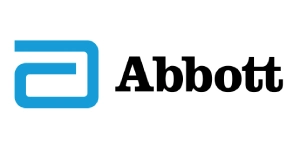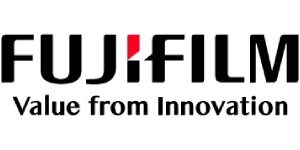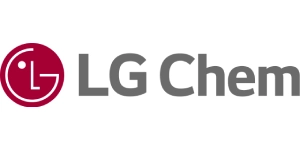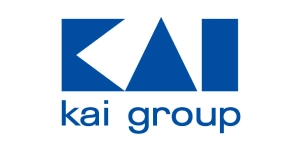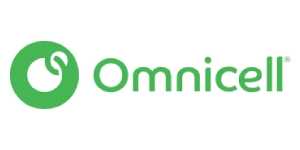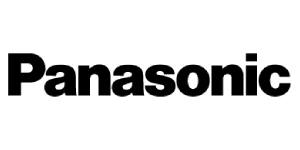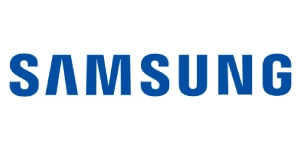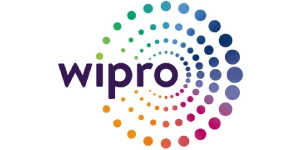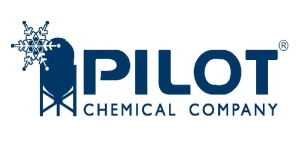Global IoT Microcontroller Market to Reach USD 13,764.76 Million by 2031 | CAGR of 13.4%
Category : Semiconductor And Electronics | Published Date : Nov 2024 | Type : Press Release
IoT Microcontroller Market Scope & Overview:
In the newly published report, Consegic Business Intelligence states that the IoT Microcontroller Market size was valued at USD 5,028.30 million in 2023 and is projected to grow at a CAGR of 13.4%, reaching USD 13,764.76 million by 2031. IoT microcontrollers serve as compact computing systems integrated into various devices to enable smart functionalities. These controllers are embedded in sensors, actuators, and electronic components for seamless connectivity and data processing. Industries such as automotive, healthcare, consumer electronics, and industrial automation rely on IoT microcontrollers for enhanced device performance, connectivity, and operational efficiency.
The report comprises the IoT Microcontroller Market Share, Size & Industry Analysis, based on Type (8 Bit, 16 Bit, 32 Bit), Connectivity (Wi-Fi, Bluetooth, ZigBee, Cellular, Others), Application (Industrial Automation, Smart Home Devices, ADAS, Wearable Devices, Medical Devices, Others), End-User (Consumer Electronics, Automotive, Healthcare, Industrial, Energy & Utility, Others), and Region (North America, Europe, Asia-Pacific, Latin America, Middle East & Africa), and Forecast, 2024-2031.
The report contains detailed information on IoT Microcontroller Market Trends, Opportunities, Value, Growth Rate, Segmentation, Geographical Coverage, Company Profiles, In-depth Expert Analysis, Revenue Forecast, Competitive Landscape, Growth Factors, Restraints or Challenges, Environment & Regulatory Landscape, PESTLE Analysis, PORTER Analysis, Key Technology Landscape, Value Chain Analysis, and Cost Analysis.
The increasing adoption of IoT devices and advancements in connectivity technologies drive the market forward.
Segmental Analysis :
Based on type, the market is segmented into 8 Bit, 16 Bit, and 32 Bit.
- The 32 Bit segment accounted for the largest share in 2023, driven by its superior performance in handling large data volumes and high-speed processing for industrial automation and ADAS applications.
- The 8 Bit segment is anticipated to grow at the fastest rate, fueled by its affordability and suitability for low-power applications such as smoke alarms and basic home appliances.
Based on connectivity, the market is segmented into Wi-Fi, Bluetooth, ZigBee, Cellular, and Others.
- The Wi-Fi segment held the largest share in 2023, attributed to its widespread use in smart home devices and industrial automation for reliable connectivity over longer ranges.
- The Bluetooth segment is projected to grow at the fastest CAGR, driven by its energy-efficient applications in wearable devices and short-range communications.
Based on application, the market is segmented into Industrial Automation, Smart Home Devices, ADAS, Wearable Devices, Medical Devices, and Others.
- The industrial automation segment dominated the market in 2023, supported by the increasing integration of IoT for remote equipment monitoring and predictive maintenance.
- The smart home devices segment is expected to grow rapidly, fueled by rising demand for smart appliances and home automation systems.
Based on end-user, the market is segmented into Consumer Electronics, Automotive, Healthcare, Industrial, Energy & Utility, and Others.
- The industrial segment accounted for the largest share in 2023, driven by the adoption of IoT microcontrollers for productivity enhancement and predictive maintenance in factories.
- The consumer electronics segment is anticipated to grow at the fastest CAGR, supported by advancements in energy-efficient smart devices such as wearables and home appliances.
Based on regions, the market is segmented into North America, Europe, Asia-Pacific, Middle East and Africa, and Latin America.
- Asia-Pacific: Held the largest market share in 2023, with China leading the region due to its robust industrialization and high adoption of smart technologies.
- North America: Expected to register the fastest growth, driven by advancements in AI and IoT connectivity in consumer electronics and healthcare.
| Report Attributes | Report Details |
| Study Timeline | 2018-2031 |
| Market Size in 2031 | USD 13,764.76 Million |
| CAGR (2024-2031) | 13.4% |
| Type | 8 Bit, 16 Bit, 32 Bit |
| Connectivity | Wi-Fi, Bluetooth, ZigBee, Cellular, Others |
| Application | Industrial Automation, Smart Home Devices, ADAS, Wearable Devices, Medical Devices, Others |
| End-User | Consumer Electronics, Automotive, Healthcare, Industrial, Energy & Utility, Others |
| By Region | North America(U.S., Canada, Mexico) Europe(U.K., Germany, France, Spain, Italy, Russia, Benelux, Rest of Europe) APAC(China, South Korea, Japan, India, Australia, ASEAN, Rest of Asia-Pacific) Middle East & Africa(GCC, Turkey, South Africa, Rest of MEA) LATAM(Brazil, Argentina, Chile, Rest of LATAM) |
Top Key Players & Competitive Landscape :
The IoT microcontroller market is characterized by intense competition, with companies focusing on product innovation and strategic collaborations.
List of prominent players in the IoT Microcontroller Industry:
- Silicon Laboratories (U.S)
- NXP Semiconductors (Netherlands)
- ST Microelectronics (Switzerland)
- Texas Instruments (U.S)
- Infineon Technologies AG (Germany)
- Renesas Electronics Corporation (Japan)
- Advantech (Taiwan)
- Digi International (U.S)
- Microchip Technology (U.S)
- Broadcom (U.S)
Recent Industry Developments :
- June 2024: Alif Semiconductor launched Ensemble E1C, a microcontroller series featuring a low-power on-chip neural processing unit for advanced IoT applications.
- March 2024: Renesas Electronics introduced the RA2A2 microcontroller for IoT applications such as smart energy management and building automation.
- December 2023: Microchip launched the AVR EB series of microcontrollers designed to reduce noise and increase efficiency in IoT devices.
